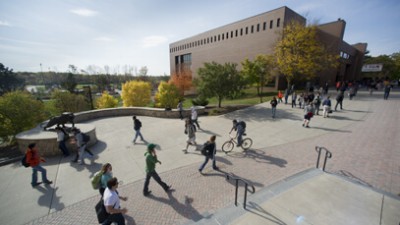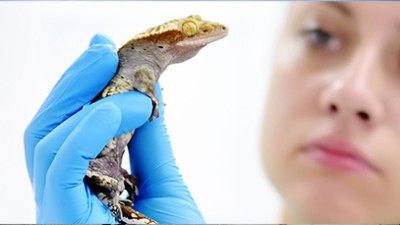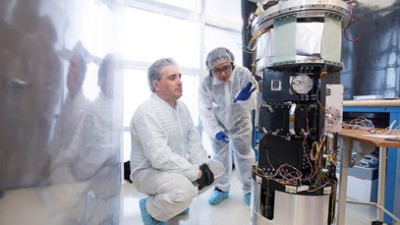News
School of Mathematics and Statistics
-
May 28, 2020
![Nathaniel Barlow and Steve Weinstein.]()
RIT scientists develop method to help epidemiologists map spread of COVID-19
Nathaniel Barlow, associate professor in RIT’s School of Mathematical Sciences, and Steven Weinstein, head of RIT’s Department of Chemical Engineering, outline a solution to the SIR epidemic model, which is commonly used to predict how many people are susceptible to, infected by, and recovered from viral epidemics, in a study published in Physica D: Nonlinear Phenomena.
-
May 26, 2020
![four researchers collecting sediment samples from a lake.]()
RIT researchers receive grant to study microplastic pollution in Lake Ontario
A team of RIT researchers will explore how tiny particles of plastic pollution are impacting Lake Ontario thanks to new funding from the National Oceanic and Atmospheric Administration. The multidisciplinary group will examine how microplastics are transported and transformed in the lake, where they ultimately end up and what effects they have on the ecosystem.
-
May 9, 2020
![debris mixed with seaweed in a lake.]()
Rochester Institute of Technology estimates 381 tons of plastic in Lake Erie -- most of it on the bottom
Cleveland.com talks to mathematical modeling doctoral student Juliette Daily and Professor Matthew Hoffman about their research on plastic pollution in Lake Erie.
-
May 8, 2020
![professor writing on giant notepad.]()
Daily dose of COVID-19 numbers: Advice for sorting out what's important
WHAM-TV talks to Ernest Fokoue, professor in the School of Mathematical Sciences, about sorting out COVID-19 data.
-
May 8, 2020
![Manuela Campanelli, Satish Kandlikar, and James Perkins]()
RIT Honors Distinguished Faculty Awardees for 2020
RIT honored its 2020 class of Distinguished Faculty—Manuela Campanelli, Satish Kandlikar and James Perkins. The Distinguished Professor designation is given to tenured faculty who have shown continued excellence over their careers in teaching, scholarly contributions, lasting contributions in creative and professional work and service to both the university and community.
-
May 5, 2020
![plastic lid stuck in the sand on a beach.]()
Lake Erie has 50 times more plastic pollution at the lake floor than at the surface
WROC-TV talks to Matthew Hoffman, associate professor in the School of Mathematical Sciences, and Ph.D. student Juliette Daily about a new study on plastic pollution in Lake Erie.
-
April 28, 2020
![photo of Juliette Daily]()
Student to Student: Microplastic pollution in the Great Lakes
In her research, Juliette Daily uses 3D models to show where microplastic pollution is collecting in the Great Lakes. As a result of her research, she is now the first author of her first published paper.
-
April 22, 2020
![map of Lake Erie with blue dots representing concentrations of plastic pollution.]()
RIT scientists develop first 3D mass estimate of microplastic pollution in Lake Erie
RIT scientists have developed the first three-dimensional mass estimate to show where microplastic pollution is collecting in Lake Erie. The study examines nine different types of polymers that are believed to account for 75 percent of the world’s plastic waste.
-
April 22, 2020
![simulation of the magnetic field lines from a rotating neutron star.]()
NSF funds RIT researchers to develop code for astrophysics and gravitational wave calculations
The National Science Foundation recently awarded researchers at RIT, the University of Illinois at Urbana-Champaign, Louisiana State University, Georgia Tech and West Virginia University grants totaling more than $2.3 million to support further development of the Einstein Toolkit, a community-developed code for simulating the collisions of black holes and neutron stars, as well as supernovas and cosmology.
-
April 9, 2020
![nurse extracting a dose of influenza vaccine]()
Developing treatments by the numbers
Developing treatments for viruses involves many experts, but where do statisticians and mathematicians fit into the equation?
-
April 8, 2020
![screenshot of coronavirus heatmap]()
Disease detectives
Do you love math? Are you a natural detective, always looking for clues? Discover how a mathematical epidemiologist tracks the growth and movement of diseases during real-life situations.
-
March 9, 2020
![professor giving lecture using large presentation paper on easel.]()
RIT professor explores the art and science of statistical machine learning
Statistical machine learning is at the core of modern-day advances in artificial intelligence, but RIT professor Ernest Fokoué argues that applying it correctly requires equal parts science and art. Fokoué emphasized the human element of statistical machine learning in his primer on the field that graced the cover of a recent edition of Notices of the American Mathematical Society.
















